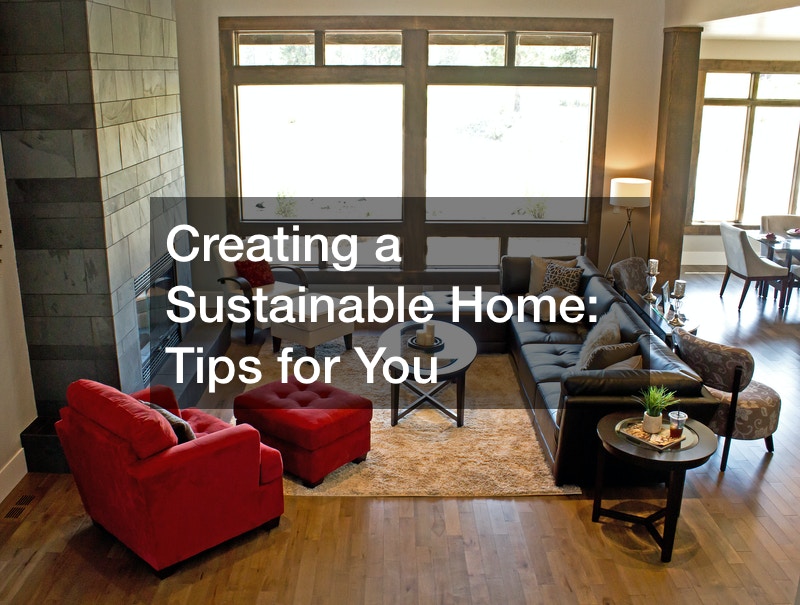
One of the main buzz words you hear batted around today — sustainability — means different things to different people. Developing an overall sustainable future means reducing our carbon footprint and transitioning to alternative fuels to eliminate our reliance on petrol and natural gas.
While this transition requires us to make significant changes in multiple areas, the first and foremost is our homes. Many ways already exist to implement sustainable technology in the home. This ranges from solar or wind energy to SMART home technologies that automatically manage problems around the house such as when the milk nearly runs out or a weather front moves in unexpectedly, requiring heat instead of cooling. Start by having an environmental risk assessment conducted on your home. It will uncover ways you can go about creating a sustainable home that addresses the most important home needs.
A sustainable household not only helps the environment but helps make your own home more efficient to run. This helps reduce waste, preserve nature, and keep the air cleaner. And while not everyone can afford solar panels, new windows, or an entirely new home, there are things you can do that will not cost you extra. Here are tips for creating a sustainable home that are easy to implement.
1. Composting

Some methods of sustainability require no technology. This includes sustainable activities such as composting. Turning your trash into fertilizer provides a useful way of keeping trash out of the landfill and putting it to good use. Your at-home recycling/composting station consists of bins for the recyclables and a pile for composting. You could buy an outdoor composter, but they cost between $100 to $600, and you could just as easily compost food scraps in the back corner of your yard. Composting can reduce your trash to the landfill by 50%. That is how much of the refuse hauled away by most cities consists of food waste. Locating recycling bins in each room of your home and next to the trash can encourage better recycling habits.
2. Enhancing Your Home’s Lighting Features
Other ways to go about creating a sustainable home include installing CFL or LED lighting. Your electrical lights account for about nine percent of your home’s energy use. That means switching to more economical and environmental methods helps you in two ways. An LED light bulb uses 80% less energy than an incandescent light bulb. They also last about 20 times as long. That means less waste in the landfill and less expense for you. You have to buy bulbs less frequently. These bulbs also emit less heat. You need not run your air conditioner as often or as high using these bulbs.
3. Sealing Your Home’s Windows and Doors
Closing the gaps around windows and doors to tightly seal them keeps cool air in during summer and cold air outside during winter. Your HVAC system’s hard work gets to stay inside your home and keep it cool or toasty based on the season. Blocking these leaks reduces your energy bill. You also reduce your carbon footprint.
4. Insulating the Attic

Creating a sustainable home also includes having professionals from HVAC services install an attic fan and/or a ceiling fan to draw hot air out of the attic and circulate the cool air that remains. This helps cool the hottest part of your home and helps you reduce its temperature. That lets you use the air conditioner less often. The other attic option includes insulating your attic. Your roof absorbs the heat of the sun. When insulated properly, the attic remains sealed against the heat. This helps your air conditioner work less hard and keeps the cool air from escaping your home.
5. Finding Sources of Renewable Energy
Creating a sustainable home includes installing solar panels or a wind turbine to harness natural energy to power the electrical needs of your home. Some areas cannot produce enough wind to run a turbine for the production of an entire household’s energy. Only certain areas of the country can produce this much wind. On the other hand, the entire country gets sunlight. You can install solar PVC panels to collect and store enough energy in batteries to power a house.
You can lease or purchase solar panels. In most areas of the United States, you would need to purchase these PVC panels. The cost for these photovoltaic panels ranges from $11,000 to $15,000. This cost applies after rebates and tax credits. Once it pays for itself, you make a return on investment since the solar panel systems typically last up to 25 years. That means you enjoy completely free electricity for 15 years. When you replace panels one at a time as they go bad or incur damage, you ensure the system lasts longer. This results in a lengthier payback before you need to upgrade to a new system. In some cases, you can avoid needing claims on your insurance policy for foundation repair.
In some areas of the country, you can sell your additional energy produced to the utility company to make back your installation costs more quickly. You will need residential roofing contractors to install solar panels on your home’s roof.
In areas that do lease these panels and converters, you can obtain them for a down payment and an interest payment. The leasing company maintains and monitors the panels, but once the contract runs out, you take responsibility for the panel system. If you sell your home while the lease remains in effect, you must have the buyer assume the lease, too. Typically, the cost of leasing the panels and converter costs less than a monthly electric bill, which results in the lack of an electric bill. The utility company may charge a small fee to connect the panels to the utility grid if you want to sell back the excess electricity you make.
6. Saving Water
Replace existing appliances with water-efficient and energy-efficient versions while creating a sustainable home. This includes washers, dryers, refrigerators, dishwashers, and ovens. These are clearly marked with Energy Star labels by the EPA, which has a third party verify the product’s claims. Your neighborhood home appliance repair service can help you choose the right appliances. While these appliances cost a bit more than typical appliances, they result in lower water and electric/gas bills.
Switching to a tankless water heater can ensure you always have hot water without pre-heating it 50 to 70 gallons at a time, as traditional heaters do. Since these tankless heaters use electricity, you can use them with solar panels or wind turbines. Avoid gas water heaters since you must replace them every 12 to 15 years.
Setting up a rainwater collection barrel can net you up to 300 gallons of water a rainstorm dumps onto your roof. You can use that water to irrigate your garden or water your lawn. Uncollected, the water simply runs into the street and then into your city’s stormwater collection system. Rather than using sprinklers and tap water, you can save yourself the expense and use rainwater. This system can also work in drought-prone areas. These collection systems can capture morning dew, evening mists, rain, sleet, snow, and other forms of precipitation.
7. Fixing Faucets and Toilets

Installing low-flow faucets and low-flush toilets can save you water, which lowers your water bill and helps in creating a sustainable home. You can also reduce your water bill by checking your plumbing for leaks. Not only can a leaking faucet or toilet or pipes cost you extra water and increase your bill, but it also causes damage to your sink and cabinetry. That leaking water can rot your wood. The EPA reports that 10% of American homes have leaks. Those leaks waste up to 90 gallons of water each day. Unaddressed, that translates to 10,000 gallons of water wasted annually. Spend the money for a plumbing service and water damage repair because the costs save you big in the long run.
If your existing shower head is of the traditional type, it releases five gallons of water per minute. A 10-minute shower uses 50 gallons. This adds up quickly, and according to the EPA, it accounts for about 17% of residential indoor water use. Switching to a low-flow showerhead uses less than two gallons per minute. These also cause less drain on water heaters. Similarly, toilets use about 30% of the water of the average home. Traditional toilets use about six gallons every time you flush. A low-flow toilet, however, uses one or fewer gallons.
8. Changing Laundry Habits
About 90% of the energy required to wash a load of laundry is heating the water, states Energy Star. Washing in cold water treats your clothing better and saves you money. You only need hot water to remove grease or oil stains. Coldwater washing extends the life of the dye used in your clothing, so it fades less. It also helps extend the life of the fabric which hot water denigrates.
Another way to extend the life of your clothing also saves you electricity. Instead of drying clothes in the dryer, hang them on a clothesline. When you line dry clothes, your clothes smell fresh without using a drier sheet.
9. Purchasing Reusable Water Bottles
Creating a sustainable home involves considering your sustainable habits. Rather than purchasing pre-filled water bottles at the store, purchase reusable water bottles. This reduces the number of waste bottles you insert in a landfill. Install a water filter to your tap, so you can obtain the taste of pre-bottled water from home. You can also have a service deliver water such as Culligan, then fill your refillable bottles from it. If you like carbonated water, purchase an at-home carbonating system. These cost less than $100 and lets you make your own sparkling and flavored waters at home.
10. Decorating with Plants and Window Treatments

Plants work as an indoor water filter. They also provide a pleasing aesthetic. You benefit from cleaner indoor air naturally since, during photosynthesis, the carbon dioxide converts into fresh oxygen and removes toxins. Consider decorating your home with blooming indoor plants.
Using window blinds and curtains protects your privacy and your furniture and carpet from fading. In winter, they help keep heat inside and, in summer, they help keep cool inside. This helps reduce your electric and/or gas bill.
11. Switching to Natural Cleaning Products
Creating a sustainable home also involves using natural cleaning products such as vinegar or lavender to get your house clean and smelling great. You only need to bleach if you must sanitize to kill germs. The natural products reduce the number of bottles or leftovers that you need to dispose of using hazardous materials management or your city’s pick-up service for contaminated material removal.
12. Using Reusable Cleaning Cloths
Paper towels and napkins create waste for landfills. Reusable cleaning cloths reduce paper waste. You wash them in cold water with the towels, and you have them ready for use for the next house cleaning project.
13. Supplementing Your Heat with a Natural Heat Source

You can use renewable energy to heat your home in the fall and winter, which contributes to creating a sustainable home. Use a fireplace, Buck stove, or pellet stove. This ensures that you can obtain warmth for your home at nearly zero cost. You chop firewood for a heat source rather than using fossil fuel like natural gas or coal. You can also use solar-powered heaters to provide heat from the sun. In times of cloudy or stormy weather though, your solar batteries may lose all their change once used. Turning to a fireplace system provides your home with heat from an alternative fuel.
A multitude of ways exists for you to live more sustainably. You will need to make a small investment to purchase the more economical and ecological appliances and projects of providing for your electricity or heating your water, but once you do this, you save money in the long run. Creating a sustainable home is both simple and effective.



